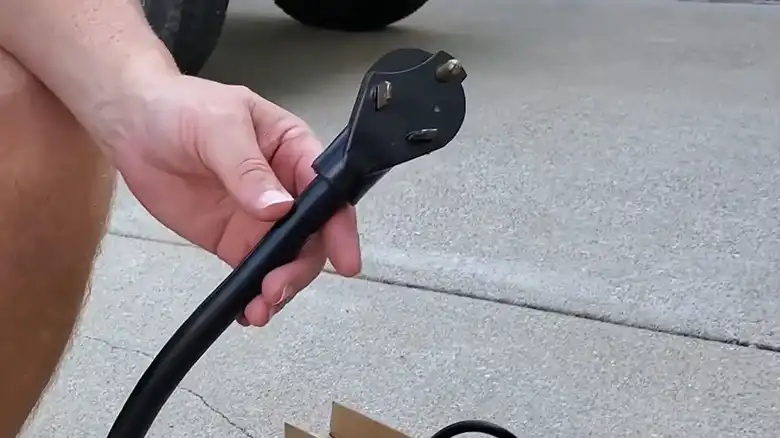If you own a recreational vehicle (RV), you may be wondering if you can or should connect it to a 220-volt (220v) power source instead of the more typical 110v power that most household devices run on. The answer, unfortunately, is not a simple yes or no. It depends on several factors, including the type of RV you have, the voltage available in your location, and your willingness to adapt.
Let’s explore the ins and outs of connecting your RV to 220-volt electrical.

Determine Your RV’s Electrical Compatibility
Not all RVs are wired to safely accept a 220v current. Before attempting to connect, you’ll want to determine if your RV’s electrical system and existing appliances can handle 220 volts. Start by thoroughly checking your owner’s manual and looking for any specifications on acceptable voltage ranges or power plug configurations. Some models indicate 110v only while other newer RVs will state something like “110/220v 50 Amp service”. Lucky for you, there’s a way to find out what voltage your RV is rated for.
For three-prong systems, the system is 30-amp, and it CAN’T handle 200V.
However, a four-pronged system, which is rated for 50-amp, can safely be plugged into 200V.
If uncertain, contact your dealer or manufacturer to verify. Getting an electrician to examine your RV’s wiring would also be wise for a second opinion. Never just assume your RV will work on 220v without explicit confirmation.
Risks of Plugging Your RV into 220V Without Verification
The main risk is plugging a 110v-only RV system into an unmatched 220v source. This is likely to severely damage appliances and other electrical components. An RV truly rated for only 110v should never connect directly to 220v. The wiring inside the RV must also be the proper gauge to safely carry a 220-volt current. Finally, any adapters used should match the expected amperage draw. Connecting RVs to electrical power requires diligent compatibility verification at every step.
Steps for Safely Connecting an RV to 220V Power
If you’ve determined your RV can properly utilize 220v, follow this checklist for safe operation:
- Have RV system certified for 220v by an electrician
- Obtain a 220v plug adapter matched in shape, amperage ratings
- Connect adapter and test appliances one by one, less critical first
- Visually check the electrical compartment for any signs of overheating
- Monitor power draw levels through your RV controller system
By methodically validating capability, and adapters, and monitoring temperature/loads, you can ensure your RV manages 220v power in a safe manner. Be prepared to revert back to 110v or disconnect immediately if you encounter any issues.
Advantages of Using 220V Power for Your RV
There are a few scenarios where having your RV configured for 220v power access would be beneficial:
Faster battery charging – At 220v with a higher-rated converter/charger, an RV battery bank will charge in far less time. This also lets you run more accessories without draining the battery.
Running high-wattage appliances – Items like A/C units, microwaves, induction cooktops, and electric heaters require more power. Upgrading to 220v allows these to run without issue.
Using RV in 220v-only locations – Some older campgrounds or sites at private residences may present 220v as the only available hookup option.
Easier system expansion – Adding a larger battery bank or solar panels in the future is more feasible if the RV electrical system is already 220v compatible.
Alternative Power Solutions for High-Power RV Needs
If modifying your RV’s electrical system to use 220v is impractical or too expensive, there are a few options to generate the needed power for short-term high-power needs:
Adapters and Converters – An external high wattage adapter like a 3000 watt power converter can allow RVs to physically plug into 220 volt outlets. The converter would model down power to 110 volt levels so internal appliances remain protected unless exclusively wired for 220 volt use.
Autotransformer – This compact device helps convert a 220 volt electricity source down to 110 or 120 volts. This offers a highly portable anytime solution to keep all outlets and devices running as normal without requiring rewiring or system changes inside an RV. They are available in various sizes and voltage transformation capacity ratings.
Electrical System Modifications – To fully unlock the benefits of 220 volt operation without relying on external adapters or transformers, a partial system rewiring by qualified professionals can enable selective 220 volt circuits powered with new outlets. That allows high power items like AC units to use 220 volts natively while lower draw appliances remain on legacy 120 volt branches.
Extra Battery/Solar Capacity – Alongside conversion and transformation devices, additional house battery/solar power can reduce dependence on shore power hookups in general, so 220 volt access becomes less important. It’s an indirect way to achieve similar benefits of high vamperage electrical access.
Use Generators – Portable generators are also a viable solution for temporary high power needs. Most will produce 110 voltage natively but many motorhomes have inbuilt generators that can be tuned for either 120 volt operation or 220 volt as needed. Depend on generators for incidental 220 volt needs during travel or boondocking when shore power outlets are unavailable.
Final Thoughts
While connecting to 220-volt outlets is very convenient when available, changing the actual wiring and components of an RV to permanently enable this power level is a major undertaking. Seek professional consultation, take it slow when testing, and always put safety first. With the right preparations, your RV can be ready to harness the benefits of ample 220-volt power.


